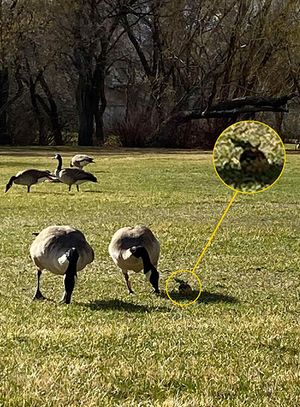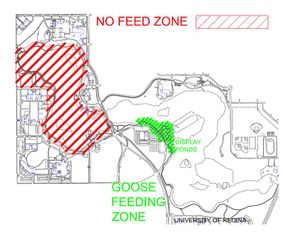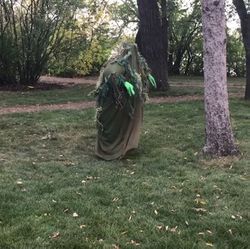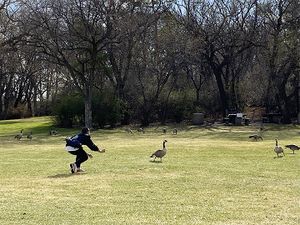Goose Cakes: Difference between revisions
| Line 17: | Line 17: | ||
==The Virtues of Geese; On Goose/Human Relations== | ==The Virtues of Geese; On Goose/Human Relations== | ||
<p>{{smallcaps|written by Rowan Lynch}} | |||
<p>[http://artsites.ucsc.edu/faculty/gustafson/FILM%20161.F08/readings/berger.animals%202.pdf We look at animals,] and in the silence between us we insert ourselves, or rather the ways they are more or less like us. I could say: geese are more blundering, less wise, show more aggression, less tranquility. This framework presents itself in the first place because humans are aggressive too! We’re loud, we lash out. We socialize in groups, we marry for life (or rather, idealize the concept). Given that geese pair up in their second year, perhaps they are more fidelitous. Geese display perseverance, and sincerity. Prudence? Temperance? Dignity? Not so much. Charisma? Hard to say. Are they introspective? They certainly don’t seem to overthink. | <p>[http://artsites.ucsc.edu/faculty/gustafson/FILM%20161.F08/readings/berger.animals%202.pdf We look at animals,] and in the silence between us we insert ourselves, or rather the ways they are more or less like us. I could say: geese are more blundering, less wise, show more aggression, less tranquility. This framework presents itself in the first place because humans are aggressive too! We’re loud, we lash out. We socialize in groups, we marry for life (or rather, idealize the concept). Given that geese pair up in their second year, perhaps they are more fidelitous. Geese display perseverance, and sincerity. Prudence? Temperance? Dignity? Not so much. Charisma? Hard to say. Are they introspective? They certainly don’t seem to overthink. | ||
| Line 27: | Line 29: | ||
<p>Thank you geese for reminding us of the continuation of cycles tied to the seasons, and for de-centring the moment we are in; thank you for your levity. Global warming and human intervention has and will disrupt this too, but for now, thank you geese for your steadiness. Thank you geese for being here at the expected time, despite everything.</p> | <p>Thank you geese for reminding us of the continuation of cycles tied to the seasons, and for de-centring the moment we are in; thank you for your levity. Global warming and human intervention has and will disrupt this too, but for now, thank you geese for your steadiness. Thank you geese for being here at the expected time, despite everything.</p> | ||
<br /> | <br /> | ||
==Isolating with Geese in Regina, SK== | ==Isolating with Geese in Regina, SK== | ||
Revision as of 12:32, 13 July 2020
Introduction

Goose Cakes is an attempt to learn more about the geese in our proximity in order to gift them a cupcake specific to their dietary needs and wants. This work will conclude with a live-streamed artist talk and goose feeding on July 20th, 2020.
Beginning with observation of geese near Wascana Lake, a man-made lake hosting a migratory bird sanctuary in Regina, Saskatchewan, the project followed Simon Fuh's own COVID influenced migration to Toronto. The second half of this project was then marked by an active search for the geese in this second city, concluding at Grenadier Pond, and an interest in the implications of the new patterns of movement COVID has introduced to our lives.
The Virtues of Geese; On Goose/Human Relations
We look at animals, and in the silence between us we insert ourselves, or rather the ways they are more or less like us. I could say: geese are more blundering, less wise, show more aggression, less tranquility. This framework presents itself in the first place because humans are aggressive too! We’re loud, we lash out. We socialize in groups, we marry for life (or rather, idealize the concept). Given that geese pair up in their second year, perhaps they are more fidelitous. Geese display perseverance, and sincerity. Prudence? Temperance? Dignity? Not so much. Charisma? Hard to say. Are they introspective? They certainly don’t seem to overthink.
This impenetrability leaves ample room for projection. The geese become whatever we need from them: specifically, a reason to risk a walk through the green pathways of High Park during a pandemic, to return to one of the only spaces I’ve found in this city where you can forget where you are. I’m looking for geese, and when I find them, they are not in any of the park's secluded areas. They are in a group of 20-25, directly beside an occupied picnic table, claiming the terrain between a main walking path and the water of Grenadier Pond. Did you know, on the Canadian Goose wikipedia page, there is a whole section reserved for "Relationship with humans?"
Within the motions of gift-giving, acceptance itself implies awareness of involvement, with all the meaningful associations that go along with it. Giving and receiving each stand as an active role. I'm sure the geese do not see it this way, but it dawned on me that we have settled on a method of interaction that provides an illusion of mutual recognition. This recognition is elusive, but receptivity proved possible. During a visit to feed the geese at Grenadier pond, we placed the dish full of corn we were holding onto the grass to see if the geese would help themselves. Instead, their enthusiasm vanished. They retreated, looking tense. Their fear of the unfamiliar container seemed to cancel out the allure of snacks. I guess they need things done a certain way to feel comfortable, and recognizing the role we could fill, we were happy to oblige.
I know that for all the enjoyment i’ve derived from it, our isolation fuelled aim of goose-human recognition is futile. So rather than heading back for the pond, I'll write it plainly here:
Thank you geese for reminding us of the continuation of cycles tied to the seasons, and for de-centring the moment we are in; thank you for your levity. Global warming and human intervention has and will disrupt this too, but for now, thank you geese for your steadiness. Thank you geese for being here at the expected time, despite everything.
Isolating with Geese in Regina, SK

Project Background
This project began somewhere in the early weeks of the COViD-19 pandemic’s initial surge in North America. I’d gone back to Saskatchewan to self-isolate, and after about a week or so it dawned on me that the only other ‘people’ that I’d really spent time with other than my partner were the Canada geese that populate Wascana Lake, Regina’s man-made water feature that dominates much of the central and southern parts of the city. The apartment that I was staying at was near a large nesting ground (Sleeping area? Hangout?) for the geese, and every morning at around 5 am the two of us would awaken from the distant honking overhead. A chorus that once unconsciously signaled the arrival of spring in the backdrop of day-to-day life had, in the absence of ‘activity’, or ‘life’, as I usually understood it, bubbled to the surface of my recognition.

This was one of the odd side-effects on social life that the pandemic seemed to have had on cities throughout the world. In the quietude of empty streets emerged birdsong, animals from the surrounding area, and common ‘pests’ like rats in search of human waste that had suddenly disappeared. The geese in Regina, however, arrive perennially. It was as though, rather than witnessing a re-emergence, it was instead my attention to detail that changed. Locked away inside (like most others who have the privilege of doing so) my daily walks became requisite for the maintenance of my own sanity. And, in my moments of boredom between anxiety, I started to notice more than did before: I walked across the frozen lake in March, and took note of the way the top of the ice sheet gradually melted in the day before freezing again at night. I observed the daily patterns of my neighborhood geese, who gathered nearby in the mornings before flying to a bay across the lake to rest at night. I stood and watched as the flock, hundreds large, organized smaller groups that marched in unison before flying away, like peeling an orange in sections. I watched the geese throw their necks up in a flailing stretch and beat their wings against their bodies. I tried to recognize their different types of honks, hisses, and mumbles, and wondered about their relationships.
As the spring unfolded, the geese spread from their initial icy landing pad. The single large flock dispersed in search of slowly greening grass in the surrounding municipal park, and they began nesting eggs in the goose-specific islands in the southeast portion of the lake: Goose Island and Tern Island, in the Wascana Lake Migratory Bird Sanctuary.

On Wascana Park, Regina
The coexistence of the animals in the sanctuary (among them, Mallards, Sandpipers, Black Tern, three varieties of Grebe, Pelicans, Loons, and Beavers, to name a few) has a tinge of strange irony to me. The lake itself is entirely artificial, and only exists because of the damming of Wascana Creek in 1883. As a self-described (small) city kid, it never really dawned on me that the lake could inhabit that much life, and, quite honestly, be that beautiful. Citizens of Regina will be familiar with the common trope that Wascana Lake is really more of a goose toilet bowl than it is a source of clean fresh water. In fact, the smell emanating from the lake got so bad in the early 2000s that it spawned a city project, the 'Big Dig', to deepen it and improve the flow of oxygen. Over the last few years, yet another ungainly tradition: the die-off of invasive carp, whose large bodies sometimes float to the surface in the thousands after the ice melt because their oxygen is cut off during the winter freeze-over. Wascana Lake’s unfortunate reputation has even spawned satires like Swamp Fest, an annual music festival whose lore features the mascot T. A. B. (Toxic Algae Blob), a creature borne out of Wascana’s mysterious and poisonous waters. Given this history, my newfound fascination with the lake as a genuinely picturesque biodiverse ecology was something of a surprise.

Goose Feeding and Friendship
This surprise spurred me to get to know the geese on a more intimate level. So, as they unfurled their wings and began to feed, I planned a gift for them in conversation with Rowan and the rest of the 'view recent changes' crew. Vegan suet, it turns out, is commonly used as a binding agent to make three dimensional shapes out of bird seed. So, I planned to make Goose Cupcakes: a decorated cupcake made from seed and other goose-friendly foods. I bought several types of nuts from the bulk foods section at my local grocer, and gathered grass from their feeding area to blend into a pipe-able icing for the cupcakes. After I shaped the nuts and seed in a muffin tin, I topped them with the icing, as well as sliced carrot, pumpkin seed and raspberry. I took several photos of the cupcakes to post to Instagram, where I was sure they would be a hit.
For whatever reason, though, the geese didn’t like the cupcake at all. I suspect the blended grass turned them away, as it looked suspiciously like goose feces. I also believe the sweet scent of the vegan suet was too unfamiliar. In the end, they completely ignored the goose cupcakes that I spent an afternoon making in favor of the plentiful grass that surrounded them. The only part of the cupcake they ate were the carrots and pumpkin seed on top. So, while my ego had taken a blow by their refusal of my gift, I learned that some fresh foods in bite sized portions are likely to be eaten with more enthusiasm.

I returned with a friend a week later with a bag full of fresh carrots and bird seed. The seed attracted several geese in the area to us (around two dozen), while the chopped carrot landed with moderate success. The geese's enthusiasm over the seed created a bit of a commotion, as certain dominant geese began to charge at others that were feeding. The dominant geese would lower their necks, run swiftly at another goose with their wings partly outstretched, and hiss aggressively. They'd bite at the white feathers at the base of the neck, pinching and pulling the skin. Blood was never drawn, but the aggression was always enough to stave off the less dominant geese. This social reaction to feeding concerned my friend and I, who protected the others from the aggressor to ensure that the all geese had an opportunity to feed. We never witnessed this sort of hoarding behavior over the grass that all geese had access to - it was only upon introducing excess, highly desirable seed that certain geese asserted dominance.
For the most part, though, this second feeding was peaceful. We gained their trust, and fed them out of our hands. I think this moment caused me to revisit my romantic view of the geese, who, before this, I had been peering at from the distant shoreline. Spending time with them deepened their character to me: they are flawed yet resilient animals. I think Rowan described them well when we visited Grenadier Pond: "Swans are like the aspirational version of love. Geese are like the reality of love." It's not that geese are less loving than other animals (swans too, I'm sure, have their moments of disagreement), it's that they wear their needs on their sleeves, and communicate directly. But at the end of the season, they always gather together as a flock and fly confidently as a group to their next location.
Written by Simon Fuh
Experience with Geese in Toronto, ON
Grenadier Pond, High Park

Grenadier Pond is a body of water located on the Western edge of Toronto's High Park. It is named after the local Town of York garrison of the 1800s and their use of the pond for fishing.
On June 27, 2020, Simon Fuh, Rowan Lynch, and Sameen Mahboubi went to feed the geese living there. Simon brought fresh uncooked corn cut from the cob, and salted, shelled sunflower seeds, and Rowan and Sameen brought an assortment of greens including carrot tops, kale, mustard greens, and lettuce.
Observations:
- The geese showed great interest in the corn, middling interest in the sesame seeds, and no interest in the greens
- We tried to guess which geese were paired up, but it was hard to tell - they seemed to aggress one another equally
- We noted that while the geese were enthusiastic about food when it was thrown on the ground for them, they were scared of the container holding the corn when we attempted placing it on the grass (to see if they would feed themselves)
- After a short period several geese from across the pond swam across to join
- Two large white swans were also nearby and partook in eating corn
- The "pecking order" amongst the local birds seemed to be Swans > Geese > Ducks
- If humans were to be added I believe it would stand at Swans > Humans > Geese > Ducks
Goose Food List
Based on trial and error, and research done by Simon Fuh and Rowan Lynch.
Food (Healthy, Unhealthy, Unsure) Notes Grass The natural staple of their diet. Fresh Corn Perhaps the most successful so far. They love corn niblets cut from the cob. Bread Not healthy for goose digestion. Carrots Mild interest. Spinach No interest. The oxalic acid interferes with calcium absorption. Kale (Organic) No interest. Mustard Greens No interest. Carrot tops No interest. Pumpkin Seeds Mild interest. Sunflower Seeds (Salted) Mild interest. Unsalted equivalent deemed safer. Bird Seed (Dollarama) High interest. Fresh seed likely healthier. Stale french fries Not healthy for goose digestion. Poutine Not healthy for goose digestion. Hot Dog Buns Not healthy for goose digestion. Ketchup Chips Not healthy for goose digestion. Corn Nuts Haven't tried this one. Probably best to err on the side of caution. Iceberg Lettuce Causes Diarrhea. Avocado Toxic to geese. for a full list of food recommendations and information, visit www.opensanctuary.org Recipes

Vegan Suet Goose Cupcake Goose Cupcake with Vegan Suet, Grass Icing and Assorted Fruits and Vegetables (Test Cupcake 1)
Success: 2/10
Ingredients:
- Arugula
- Assorted nuts (optional)
- Bird Seed
- Carrots
- Fresh corn
- Grass
- Margarine
- Pumpkin seeds
- Raspberries
- Vegan suet
Instructions:
- Mix together vegan suet with seeds and other assorted nuts until combined into a form-able paste.
- Line a muffin tin with margarine and pack the paste into the tray tightly.
- Place the muffin tin in the freezer for 30 minutes.
- While the seed-muffins are freezing, blend together grass and remaining vegan suet. Add water as necessary to maintain a viscous texture. The grass will get stuck in the blades of the blender. This will be very hard to clean out.
- Once the grass is blended place it in a pipette and pipe it onto the frozen cupcakes.
- Use the remaining fruits and vegetables to decorate the top of the cupcakes to make them look cute!

Inspiration for tartare recipe (from Cilantro and Citronella) Deconstructed Corn Bread Tartare
Success: Untested (will present on July 20, 2020)
Ingredients:
- Fresh Corn on the cob (2)
- Assorted unsalted nuts (optional)
- Bird Seed (optional)
- Carrots
- Sprouts or micro greens
- Beets (2)
- Pumpkin seeds
- Podded Peas
Instructions:
- Cut the corn off the cob in niblets. Set aside half the niblets, and lightly blend the other half.
- Dice the beets and press them into a tartare mould. Alternatively, use an empty food can.
- Press the corn on top of the avocado.
- Place the mould in the fridge on a plate until ready to serve.
- When ready, remove the mould and garnish with micro greens or sprouts, unsalted nuts and seeds, carrot shavings, and the rest of the un-blended corn niblets. Serve to hungry geese.